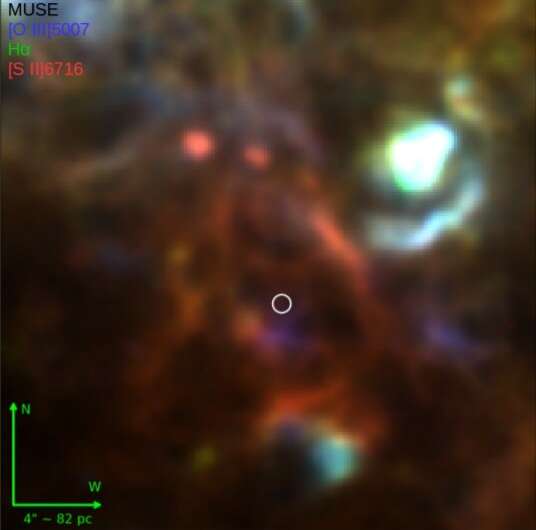February 1, 2022 report
Peculiar ionized structures, supernova remnants detected around an ultraluminous X-ray source

Using the Very Large Telescope (VLT), French astronomers have performed spectroscopic observations of an ultraluminous X-ray source known as NGC 1313 X–1. The observational campaign resulted in the detection of a shocked-ionized bubble, an X-ray photoionized nebula and also two supernova remnants around this source. The findings were published January 23 on arXiv.org.
Ultraluminous X-ray sources (ULXs) are point sources in the sky that are so bright in X-rays that each emits more radiation than 1 million suns emit at all wavelengths. They are less luminous than active galactic nuclei, but more consistently luminous than any known stellar process. Although numerous studies of ULXs have been conducted, the basic nature of these sources remains unsolved.
NGC 1313 X–1 is a ULX in the spiral galaxy NGC 1313 at a distance of some 13.85 million light years away from the Earth. The ULX is located in the northern part of NGC 1313, within the inner radius (about 3,100 light years) from the nucleus of the galaxy. It has a persistent unabsorbed luminosity in the 0.3–10 keV band above 8 duodecillion erg/s, with a mean luminosity of around 11 duodecillion erg/s.
Previous observations of this source have shown that it is one of only a few ULXs known to experience powerful winds with relatively high velocities. This indicates that NGC 1313 X–1 harbors a supercritically accreting source, whose nature still remains unclear. It is assumed that such winds are powerful enough to produce huge bubbles (with a size of over 300 light years) sometimes seen around ULXs.
A team of astronomers led by Andrés Gúrpide of the University of Toulouse in France, now reveals that NGC 1313 X–1 is indeed surrounded by an ionized bubble, what was suggested by previous studies. The new finding is based on spectroscopic observations of this ULX using VLT's Multi-Unit Spectroscopic Explorer (MUSE) instrument.
MUSE observations found that NGC 1313 X–1 ionizes a region about 1,473 by 867 light years in size, via extreme ultraviolet (EUV)/X-ray excitation and shocks. This bubble is roughly centered around the ULX, and evidence for shock ionization can be clearly seen in its outer edges.
Studying further this shocked-ionized bubble, the researchers estimated that the shock velocities should be between 160 and 180 km/s. They calculated that an average and continuous outflow power of around 20−45 duodecillion erg/s over a timescale of some 450,000 to 780,000 years is required to inflate this bubble.
Moreover, the astronomers detected an extended X-ray photoionized nebula, estimated to be 456 light years in size, in the interior of the bubble. Its elongated shape may indicate the presence of jet activity in this nebula.
The study also identified two supernova remnants (SNRs) coincidentally close to the ULX bubble. The researchers estimate that the two supernovae exploded between 24,000 and 34,000 years ago, and had initial explosion energies at a level of about 0.5 sexdecillion ergs.
More information: MUSE spectroscopy of the ULX NGC 1313 X-1: a shocked-ionised bubble, an X-ray photoionised nebula and two supernova remnants, arXiv:2201.09333 [astro-ph.HE] arxiv.org/abs/2201.09333
© 2022 Science X Network





















